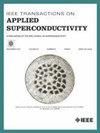用于MARCO螺线管探测磁体的铜中卢瑟福通道导体
IF 1.8
3区 物理与天体物理
Q3 ENGINEERING, ELECTRICAL & ELECTRONIC
引用次数: 0
摘要
MARCO将是一个超导螺线管,用于布鲁克海文国家实验室(NY, USA)即将到来的电子离子对撞机的新粒子物理探测器。相互作用点处的设计场为2.0 T,在4.5 K时标称电流约为4ka。对于这种磁铁,在非常初步的设计阶段就考虑了铝稳定导体。此后,由于缺乏能够处理铝挤压的制造商,选择了铜作为稳定剂。由于专门的设计努力,铜稳定剂和伴随的材料选择提供了可接受的强子相互作用长度。导体是基于一个NbTi卢瑟福电缆,焊接在一个u型铜轮廓。本文根据项目要求和供应商能力,详细介绍了导线截面的定义。它的特性将被详细讨论,特别是RRR和铜通道的屈服强度,分别用于保护和力学。最后,对如何制作两导体之间的接头提出了建议。本文章由计算机程序翻译,如有差异,请以英文原文为准。
Rutherford-in-Copper-Channel Conductor for the MARCO Solenoidal Detector Magnet
MARCO will be a superconducting solenoid for a new particle physics detector of the upcoming electron ion collider at Brookhaven National Laboratory (NY, USA). The design field at the interaction point is 2.0 T with a nominal current of about 4 kA at 4.5 K. For this magnet, an aluminum-stabilized conductor was considered at the very preliminary design phase. After that, due to the lack of manufacturers able to deal with aluminum extrusion, copper has been chosen as a stabilizer. Thanks to a dedicated design effort, the copper stabilizer and accompanying material choices provided acceptable hadronic interaction length. The conductor is based on an NbTi Rutherford cable that is soldered in a U-shaped copper profile. This article goes through the definition of the conductor cross section according to the project requirements and the supplier capabilities. Its characteristics will be detailed and discussed, in particular the RRR and the yield strength of the copper channel needed for protection and mechanics, respectively. Finally, a proposal on how to make the joint between two conductors is presented.
求助全文
通过发布文献求助,成功后即可免费获取论文全文。
去求助
来源期刊

IEEE Transactions on Applied Superconductivity
工程技术-工程:电子与电气
CiteScore
3.50
自引率
33.30%
发文量
650
审稿时长
2.3 months
期刊介绍:
IEEE Transactions on Applied Superconductivity (TAS) contains articles on the applications of superconductivity and other relevant technology. Electronic applications include analog and digital circuits employing thin films and active devices such as Josephson junctions. Large scale applications include magnets for power applications such as motors and generators, for magnetic resonance, for accelerators, and cable applications such as power transmission.
 求助内容:
求助内容: 应助结果提醒方式:
应助结果提醒方式:


